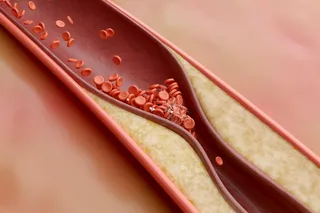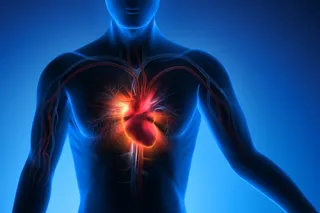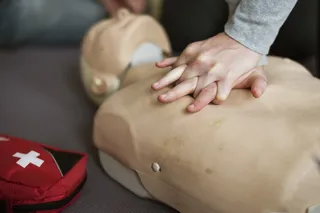A wave of nausea slammed Mr. Moran, a 55-year-old architect, back in his chair. His heart skipped, fluttered and, for a moment, seemed to stop. Then it pounded back like a jackhammer, beating so hard inside his chest that his lungs could barely draw breath. Mr. Moran felt as if his core were crumbling, but somehow he walked the four blocks from his office to the emergency room. The triage nurse took one look at the sweaty, deathly pale man before her and rushed him to the cardiac unit. Rebecca, the second nurse, slapped on a monitor, then ran to grab me.
"His pressure's barely 90," she said, steering me into the room. "I think he's in V-tach."
While nurses rushed to set up equipment and Mr. Moran struggled to fight back panic, I ignored everyone and everything except the heart monitor. Rebecca was right. Interspersed among normal beats came fast salvos of wide, slurred shapes. They were a clear indication of V-tach, or ventricular tachycardia, a severe form of heart arrhythmia.
Normally, heartbeats appear on electrocardiograms as tight, high spikes. The tightness reflects the efficiency of the heart's electrical conducting system. Impulses start in the natural pacemaker located high in the heart's right corner. They spread through the atria, hit the atrioventricular node at the junction of the four chambers, then zip through special electricity-conducting cells to the tips of the ventricles and trigger smooth, coordinated contractions.
V-tach arises from abnormal or diseased tissue in the ventricles that starts firing electrical impulses willy-nilly. The wide tracings that show up on an electrocardiogram reflect less efficient conduction through neighboring muscle fibers, as opposed to the fast-acting cells that carry the electrical impulses. When that happens, the ventricle has less time to recover for another contraction, and it beats too weakly to support a decent blood pressure. Left unchecked, V-tach will continue until it exhausts the heart or provokes a lethal, chaotic rhythm called ventricular fibrillation.
A cascade of drug recipes lit up in my head: 100 mg of IV lidocaine, followed by doses of 50 mg every five to 10 minutes. If that doesn't work, start an IV drip of Pronestyl. Rebecca held up a vial of lidocaine, the antiarrhythmic the books say to use first, but which I like less than Pronestyl. I nodded, adding, "One hundred push, then drip at four a minute."
I turned to my patient. "Mr. Moran? I'm Doctor Dajer. How are you feeling?""Nice to meet you, doctor." He gave me a wan smile. "Feel lousy, to tell the truth. Will I be okay?""You're gonna be fine," I said. "The problem is that some strips of tissue in the right side of your heart have decided to generate electrical beats they normally have no business sending."Above all, I needed to keep him calm. We chatted about the weather, his sons, the Yankees, his recent trip to Italy, and how much he loved being an architect. Fifteen minutes later we had reached the maximum lidocaine dose. The heart monitor showed a slightly better pattern, but still too many wacky beats. Worse, his blood pressure wasn't coming up."Excuse me, Mr. Moran." I turned to Rebecca. "Pronestyl time. One gram over 50 minutes."
I love Pronestyl. It quiets the abnormal cells, which allows normal beats to resume. The only problem is that it takes almost an hour to give a loading dose; if administered too fast, Pronestyl lowers blood pressure or provokes serious EKG abnormalities.
"Let's hit the blood pressure monitor every few minutes instead of every five minutes," I told Rebecca. "The Pronestyl."
Subtly, the tide turned. Normal beats began to outnumber the V-tach. The overall rate slowed. The blood pressure came up. And then, in an instant, all the beats became clean, crisp, and normal. The blood pressure bounced up to 130/90. Mr. Moran looked around and said, "Hey, I feel better."
For the next 30 minutes I tinkered with the lidocaine and Pronestyl drips. At one point I turned off the lidocaine. Within seconds the unruly beats were back. Mr. Moran reached for his chest.
"Feels funny," he said.
"I was trying to see what your minimum was." I caught the look of disappointment on his face. "Not a setback," I explained. "Simply an adjustment. You're doing great."
The next morning I found him upstairs in the coronary care unit reading a novel.
"Good night?" I asked.
"Slept well. No funny business in there." He tapped his chest. "I guess today they're going to laser it or zap it or something."
"Actually," I explained, "what they're going to do is cook it."
Just two decades ago, doctors had only two treatment options for controlling the abnormal heart rhythms of patients with V-tach: open-heart surgery or long-term medication. Then, when I was a resident in the early 1980s, medical technologists perfected a technique for mapping electrical pathways by placing electrode-tipped catheters into the heart via the groin's femoral vein. This made it possible for doctors to stimulate a patient's arrhythmia on command in order to test which medication best suppressed it. Continued refinements in electrophysiological testing soon led to catheter ablation. The logic was simple: Rather than map and medicate, why not zap the offending tissue with enough electricity to kill it? The first-generation catheters used DC current and delivered uncomfortable, somewhat uncontrollable jolts. But by the early 1990s, catheters using energy in the radio-frequency range (just above microwave on the electromagnetic spectrum) had revolutionized the field. A radio-frequency catheter, like the one we planned to use in Mr. Moran's treatment, can instantaneously cook troublesome cells without damaging underlying healthy cardiac tissue.
In the cardiac catheterization lab, the first order of business was to look at Mr. Moran's coronary arteries. We needed to make sure his ventricle hadn't misfired because it was starved of oxygen-rich blood. A team of two cardiologists inserted a catheter into his left femoral artery, threaded it up the aorta, and placed the tip at the opening of the left, then the right coronary artery. They injected radio-opaque dye. On the fluoroscope screen, Mr. Moran's arteries filled plump and smooth. His coronaries were clean. Then the cardiologists threaded two electrode-tipped catheters into the left femoral vein and one in the right. One was advanced up the venous system to the right atrium, another to the tip of the right ventricle, and the third to the roof of the ventricle where the normal conduction trunk lines come through. First the cardiologists measured how long it took a normal beat to make it from atrium to ventricle. To test the conduction backward, they stimulated the right ventricle to send impulses to the right atrium. Mr. Moran's wiring system passed with flying colors.
The next step was to induce the arrhythmia in order to identify the specific problem cells. Using catheters in different parts of the heart, the cardiologists delivered faster and faster stimuli to electricity-conducting heart cells. They also infused a medication called Isuprel, which gooses the heart like a bee sting to a horse's backside. Within seconds, the wide, sawtooth salvos I had seen in the ER appeared on the electrocardiogram monitor. The cardiologists stopped to let Mr. Moran catch his breath. Then they positioned their catheters in the high right ventricle where the pulmonary artery comes off—fertile ground, for some reason, for V-tach. Almost immediately they hit pay dirt: clumps of cells that activated about 1Ú50 second too soon. Next they brought out a catheter tipped with an electrode to burn off tissue. Poking once more into the right femoral vein, one of the cardiologists snaked the catheter into the right ventricleÑexactly where he had picked up the early—firing signals. Then his partner let fly. For 30 seconds, the room hummed with the energy discharge. Mr. Moran felt nothing. The cardiologists peered at the monitor. Still some signs of misfiring. Another touch with the catheter. Then one more. And then they were done.
Mr. Moran's been going strong ever since. He wrote me a nice letter of thanks. He did not ask the one question that neither I nor his cardiologists could answer: Why V-tach in an otherwise healthy 55-year-old?
The heart's electrical system is as finely crafted as a microchip. Tough enough to last 100 years, it can nonetheless be short-circuited by congenital miswiring, the tiny scar of a viral infection, a touch of atherosclerosis, or even an extra cup of cappuccino. The cause of Mr. Moran's heart malfunction on that particular day, at that particular hour, could be any of the above— or none.














